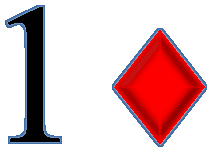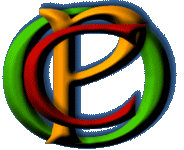 One Diamond
One Diamond
The 1♦ Opening is a catch-all opening for any hand in the 11-15 point range that is not catered for by one of the other Intermediate Openings (1♥, 1♠, 1NT, and 2♣ in this system). It specifically denies the following holdings:
- 5-card Major (Open 1♥ or 1♠)
- 6-card Club suit unless very weak (Open 2♣)
- 5-card Club suit (unless very weak) with a 4-card Major (Open 2♣)
- Balanced or Semi-balanced with a 5-card Minor in the 1NT hcp range (Open 1NT)
- Balanced or semi-balanced hands in the wrong point range for 1NT
- 11-15 points and any 4441 shape
- Note: Standard Precision uses a 2♦ Opening to show 11-15 points and 4414 shape (Singleton Diamond). This Precision system does not follow that method and the 2♦ Opening is used to show 16-23 points hands with any 4441 shape
- 11-15 points with a weak 6-card club suit unsuitable for a 2♣ Opening (or possibly a very weak 5-card Club suit with a 4-card Major)
- 11-15 point hands with any 5-card or longer Diamond suit not covered by another opening (ie: not semi-balanced, not with a 6-card Club suit and not with a 5-card Major
Initial Responses
In response to the 1♦ Opening, partner bids along the following lines:| 1♦-Pass |
Partner should not be afraid to pass with a weak hand whether or not it contains Diamond support. It is rare that opponents will be able to profit significantly if they pass the hand out when having the balance of the points, whether or not they have Diamonds. Normally they will bid or double for takeout.
|
|
| 1♦-1♥ |
4-card suit, a 1-round force. Now all continuations are natural. Any Opener's rebid other than 1♠ denies holding 4-card Spades, and any rebid other than 2♥ denies 4-card Heart support. A rebid of 2♣ will
usually contain 4-card Diamonds as well (unless a weak 6-card Club suit).
|
|
| 1♦-1♠ |
4-card suit, a 1-round force. This response specifically denies holding 4-card Hearts unless the Spades are longer and Responder is strong enough to bid twice. Now all continuations are natural. Any rebid other than 2♠ denies 4-card Spade support. A rebid of 2♣ will usually contain 4-card Diamonds as well (unless a weak 6-card Club suit). A Rebid of 1NT might conceal a 4-card Heart suit. A rebid of 2♥ is a reverse promising 5-card Diamonds in addition to being maximum.
|
|
| 1♦-1NT |
8-10 balanced. This bid specifically denies possession of a 4-card or longer Major. All continuations are natural. A reverse into 2♥ or 2♠ promises 5-card or longer diamonds as well. In practice, Opener will often pass this response unless minimum and unbalanced with both minors, in which case the best action will often be to bid 2♣ even if Opener's Diamonds are longer, since the 2♣ bid normally shows 4-5 in the Minors and Responder must have at least one 4-card Minor suit.
|
|
| 1♦-2♣ |
Natural and forcing to 2NT at least with 11+ points. Unless responder is strong enough to force to game by reversing this bid tends to deny possession of a 4-card Major. All continuations are natural.
|
|
| 1♦-2♦ |
Natural and forcing to 2NT at least with 11+ points. Unless responder is strong enough to force to game by reversing this bid tends to deny possession of a 4-card Major. All continuations are natural, but Responder should bear in mind that Opener may be 4414 shape with a singleton Diamond. If Responder has the choice between responding 2♣ or 2♦, they should normally prefer the 2♦ response, because it puts less pressure on Opener's rebids (After 1♦-2♦ Opener can freely show a 4-card Major if they have one, but after 1♦-2♣, a bid in a Major by Opener is a reverse)
|
|
| 1♦-2♥ |
Game-forcing and Alpha in Hearts with 16+ points.
|
|
| 1♦-2♠ | Game-forcing and Alpha in Spades with 16+ points. | |
| 1♦-2NT | 16+ points (balanced in principle). Game-forcing enquiry. Opener rebids as follows:- | |
| -3♣ | 5-card Clubs and 4-card Diamonds, upper-range | |
| -3♦ | 5-card Diamonds, upper-range. May have a 4-card Major if 2245 shape | |
| -3♥ | 4-card Hearts, lower-range, or any range if semi-balanced or balanced (including 2452 shape) | |
| -3♠ | 4-card Spades, lower-range, or any range if semi-balanced or balanced (including 4252 shape). Denies holding 4-card Hearts.
|
|
| -3NT | Any lower-range (ie: <14 hcp) hand not containing a 4-card Major | |
| -4♣ | Weak 6-card Clubs, Upper Range | |
| -4♦ | 6-card Diamonds, Upper Range. Denies a 4-card Major as well. | |
| -4♥/4♠ | 4-card Major with 5+ Diamonds, upper range and not 2452 or 4252 shape | |
| -4NT | Upper-Range (ie: 15-count) balanced hand with no 4-card Major (3343, 3334, 2344 or 3244). Effectively quantitative. | |
| Note: Continuations over Opener's Rebids are almost entirely natural. There is scope for Gamma Asks in a Minor at the 4-level, but Eta's in a Major will inevitably be at at least the 4-level, and so ambiguous, depending on Opener's range. | ||
| 1♦-3♣ | Game-forcing and Alpha in Clubs with 16+ points. | |
| 1♦-3♦ | Game-forcing and Alpha in Diamonds with 16+ points. | |
General Tactics
Passing 1♦It will be seen from the above that Opener may have only a singleton diamond (may be 4414 shape or have short diamonds with a weak 6-card club suit). Despite this, Responder should not be afraid to pass with a weak hand and short diamonds. It will be rare that opps can and will be prepared to pass out the Opening when they have the balance of the points and stronger diamonds. If the Opening is doubled, at least one of the partnership will have a chance to rescue. In principle, doubles and redoubles by Opener are for takeout or SOS respectively. By Responder, doubles tend to be Negative in character and a Redouble is punitive, showing values.
Accepting Moysians
In the natural sequences above (particularly those starting with 1♦-1♥/♠), the emphasis is usually on reaching a workable fit at as low a level as possible. It will often be profitable to accept a low-level Moysian (4-3) fit in a Major if the hand with the 3-card suit has a ruffing value. If Responder has invitational or game-going values they have more options to bid their suits in the "natural" order.
2♣ Rebids by Opener
Please note that a sequence such as 1♦-1M-2♣ does not promise a Minor 2-suiter. It does guarantee 5+ Clubs and will normally have 4-card Diamonds as well, but might be a weak 6-card Club suit, so Responder should be wary of supporting Diamonds above the level of 3NT until a 4-5 or 4-6 Minor 2-suiter is confirmed. It is up to each partnership to decide, for the purposes of 3-suited Lebensohl, whether to treat a 2♣ rebid by Opener as showing both Minors or not. Most OCP partnerships tend to agree to treat 1♦-1M-2♣ as a 3-suited sequence for Lebensohl purposes. (See section on Lebensohl below)
Hands unsuitable for a 2♣ Opening
It is comparatively rare that an 11-15 Opening with a 6-card or longer Club suit has a weak enough Club suit that a 2♣ Opening would be wrong. Hands with a very weak 5-card Club suit and a 4-card Major, however, seem to occur more frequently and these can cause a problem. Oliver's suggestion is that with a minimum hand of this type, it's usually better to pass initially and hope to come in later on. Alternatively, when not-vulnerable, 11-12, and with 2425 or 4225 shape Opener has the option to open 1NT. Opening 2♣ with such a hand can be dangerous if the Club suit is filthy-weak, but opening such a hand with 1♦ really does present Opener with rebid problems, especially over a 2NT Response, because weak 5-card Clubs and a 4-card Major is not specifically catered for in the Opener's Rebids.
Lebensohl after 1♦
Opportunities for Lebensohl in 3-suited sequences and after a reverse do occur over a 1♦ Opening. What you have to remember is that 1♦ does not show a Diamond suit of itself, but in a sequence such as 1♦-1♠-2♥ a 5-card or longer Diamond suit has explicitly been shown by the reverse into Hearts, so this is a 3-suited unopposed sequence, not to mention the reverse, so Lebensohl applies. Thus over 1♦-1♠-2♥- 3♣ is 4th-suit Forcing (a general rather than a specific 4SF here, as a slow 4SF in Clubs not possible)
- 3♦ is constructive and forcing.
- 2NT-3♣-3♦ is "to play"
- 4♣ shows a Heart shortage, 3/4-card Diamond support, 5-card Spades and about 14-15 points
- 3♠ is strong and forcing in Spades
- 3♥ is forcing, agreeing Hearts.
- 2NT-3♣-3♥ is invitational in Hearts
Complex System
The so-called Complex System has a completely different scheme of responses and continuations to those shown above. For example, the initial responses from 1♥ up to and including 1NT all show hcp ranges irrespective of Responder's distribution and bids from 2♣ up to 2♠ are all Alpha in the suit bid.It is not recommended that you experiment with the Complex version of the 1♦ Opening, however, unless you are going to include all of the Complex System. This is because some hand-types are removed from the 1♦ Opening in the Complex System (eg: 11-15 hands with a 4-card Major and 5-card Diamonds) and included in Complex Opening Bids from 2♦ upwards that have no equivalent in the Simple System. You can, however, play the Complex System without using the Complex 1♦ responses.
Even the Complex System, however, reverts to the scheme of responses shown above when Responder is a passed hand.

